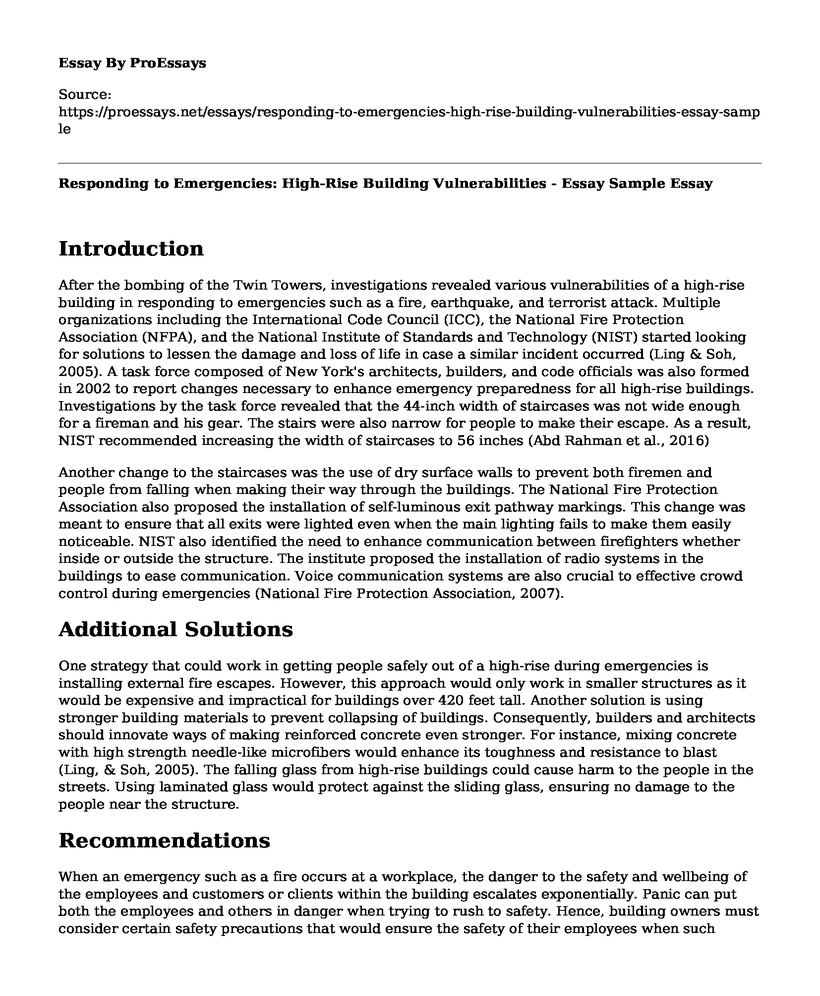Introduction
After the bombing of the Twin Towers, investigations revealed various vulnerabilities of a high-rise building in responding to emergencies such as a fire, earthquake, and terrorist attack. Multiple organizations including the International Code Council (ICC), the National Fire Protection Association (NFPA), and the National Institute of Standards and Technology (NIST) started looking for solutions to lessen the damage and loss of life in case a similar incident occurred (Ling & Soh, 2005). A task force composed of New York's architects, builders, and code officials was also formed in 2002 to report changes necessary to enhance emergency preparedness for all high-rise buildings. Investigations by the task force revealed that the 44-inch width of staircases was not wide enough for a fireman and his gear. The stairs were also narrow for people to make their escape. As a result, NIST recommended increasing the width of staircases to 56 inches (Abd Rahman et al., 2016)
Another change to the staircases was the use of dry surface walls to prevent both firemen and people from falling when making their way through the buildings. The National Fire Protection Association also proposed the installation of self-luminous exit pathway markings. This change was meant to ensure that all exits were lighted even when the main lighting fails to make them easily noticeable. NIST also identified the need to enhance communication between firefighters whether inside or outside the structure. The institute proposed the installation of radio systems in the buildings to ease communication. Voice communication systems are also crucial to effective crowd control during emergencies (National Fire Protection Association, 2007).
Additional Solutions
One strategy that could work in getting people safely out of a high-rise during emergencies is installing external fire escapes. However, this approach would only work in smaller structures as it would be expensive and impractical for buildings over 420 feet tall. Another solution is using stronger building materials to prevent collapsing of buildings. Consequently, builders and architects should innovate ways of making reinforced concrete even stronger. For instance, mixing concrete with high strength needle-like microfibers would enhance its toughness and resistance to blast (Ling, & Soh, 2005). The falling glass from high-rise buildings could cause harm to the people in the streets. Using laminated glass would protect against the sliding glass, ensuring no damage to the people near the structure.
Recommendations
When an emergency such as a fire occurs at a workplace, the danger to the safety and wellbeing of the employees and customers or clients within the building escalates exponentially. Panic can put both the employees and others in danger when trying to rush to safety. Hence, building owners must consider certain safety precautions that would ensure the safety of their employees when such incidences happen. One recommendation is installing automatic stairwell door unlocking systems to help occupants move safely out. Firefighters would also be able to gain access into the building easily as well as get people out of danger. On several occasions, people have lost their lives by unintentionally trapping themselves during emergencies when doors fail to open or lock behind them.
Another recommendation is for high-rises to be code compliant by having elevator recalls. A fire alarm should automatically activate this feature. By having designated floor for all elevators during the recall, the fire department would be able to put up a command center. Finally, all occupants in the high-rise building should be made aware of safety procedures during emergencies. In most cases, building managers and business owners only provide such information in the form of brochures and posters. A proactive strategy would involve carrying out regular sessions to remind their employees of safety procedures inform of drills because posters and pamphlets are easily overlooked.
References
Abd Rahman, N., Goh, K. C., Goh, H. H., Omar, M. F., Toh, T. C., Zin, M., & Rahmat, S. N. (2016). Accidents preventive practice for high-rise construction. In MATEC Web of conferences (Vol. 47, pp. 1-6). EDP Sciences.
Ling, F. Y. & Soh, L. H. (2005). Improving the design of tall buildings after 9/11. Structural Survey.
National Fire Protection Association. (2007). National Electrical Code: 2008. National Fire Protection Assoc.
Voskresenskaya, E., & Vorona-Slivinskaya, L. (2018). Development of national standards related to the integrated safety and security of high-rise buildings. In E3S Web of Conferences (Vol. 33, p. 03052). EDP Sciences.
Cite this page
Responding to Emergencies: High-Rise Building Vulnerabilities - Essay Sample. (2023, Apr 26). Retrieved from https://proessays.net/essays/responding-to-emergencies-high-rise-building-vulnerabilities-essay-sample
If you are the original author of this essay and no longer wish to have it published on the ProEssays website, please click below to request its removal:
- SCADA Protection Overlap Amongst the Corporate Groups and Governmental Agencies
- Bipolar Disorder and Dementia: Case Study
- Questions and Answers Essay on Nursery and Healthcare
- Essay Sample on Managing the Multi-Generational Nursing Workforce
- Is Poverty a Crime? Examining Barbara Ehrenreich's NYT Piece
- Article Analysis Essay on "What the Litterers Tell Themselves" and "Poverty in America"
- Paper Example on Health Benefits of Walking for Older Adults: A Limited-Bias Study







